Europe's Rosetta spacecraft pulled alongside an oddball comet Wednesday, concluding a decade-long journey from Earth for the most comprehensive exploration of a comet in history.
Scientists released fresh images of comet 67P/Churyumov-Gerasimenko, revealing a weirdly-shaped world marked with craters, cliffs and rough terrain.
The images are the sharpest ever views of a comet's nucleus, according to Holger Sierks, principal investigator for Rosetta's OSIRIS camera suite from the Max Planck Institute for Solar System Research in Gottingen, Germany.
See our Mission Status Center for additional coverage.
Close-up detail of comet 67P/Churyumov-Gerasimenko. The image was taken by Rosetta's OSIRIS narrow-angle camera and downloaded today, 6 August. The image shows the comet's 'head' at the left of the frame, which is casting shadow onto the 'neck' and 'body' to the right. The image was taken from a distance of 120 km and the image resolution is 2.2 metres per pixel. Credit: ESA/Rosetta/MPS for OSIRIS Team MPS/UPD/LAM/IAA/SSO/INTA/UPM/DASP/IDA
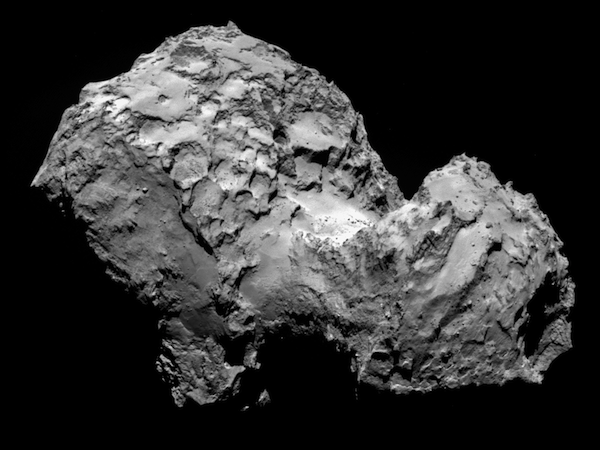 Comet 67P/Churyumov-Gerasimenko by Rosetta's OSIRIS narrow-angle camera on 3 August from a distance of 285 km. The image resolution is 5.3 metres/pixel. Credit: ESA/Rosetta/MPS for OSIRIS Team MPS/UPD/LAM/IAA/SSO/INTA/UPM/DASP/IDA
Comet 67P/Churyumov-Gerasimenko by Rosetta's OSIRIS narrow-angle camera on 3 August from a distance of 285 km. The image resolution is 5.3 metres/pixel. Credit: ESA/Rosetta/MPS for OSIRIS Team MPS/UPD/LAM/IAA/SSO/INTA/UPM/DASP/IDA
 Comet 67P/Churyumov-Gerasimenko by Rosetta's OSIRIS narrow-angle camera on 3 August from a distance of 285 km. The image resolution is 5.3 metres/pixel. Credit: ESA/Rosetta/MPS for OSIRIS Team MPS/UPD/LAM/IAA/SSO/INTA/UPM/DASP/IDA
Comet 67P/Churyumov-Gerasimenko by Rosetta's OSIRIS narrow-angle camera on 3 August from a distance of 285 km. The image resolution is 5.3 metres/pixel. Credit: ESA/Rosetta/MPS for OSIRIS Team MPS/UPD/LAM/IAA/SSO/INTA/UPM/DASP/IDA
 Comet 67P/Churyumov-Gerasimenko activity on 2 August 2014. The image was taken by Rosetta's OSIRIS wide-angle camera from a distance of 550 km. The exposure time of the image was 330 seconds and the comet nucleus is saturated to bring out the detail of the comet activity. Note there is a ghost image to the right. The image resolution is 55 metres per pixel. Credit: ESA/Rosetta/MPS for OSIRIS Team MPS/UPD/LAM/IAA/SSO/INTA/UPM/DASP/IDA
Comet 67P/Churyumov-Gerasimenko activity on 2 August 2014. The image was taken by Rosetta's OSIRIS wide-angle camera from a distance of 550 km. The exposure time of the image was 330 seconds and the comet nucleus is saturated to bring out the detail of the comet activity. Note there is a ghost image to the right. The image resolution is 55 metres per pixel. Credit: ESA/Rosetta/MPS for OSIRIS Team MPS/UPD/LAM/IAA/SSO/INTA/UPM/DASP/IDA
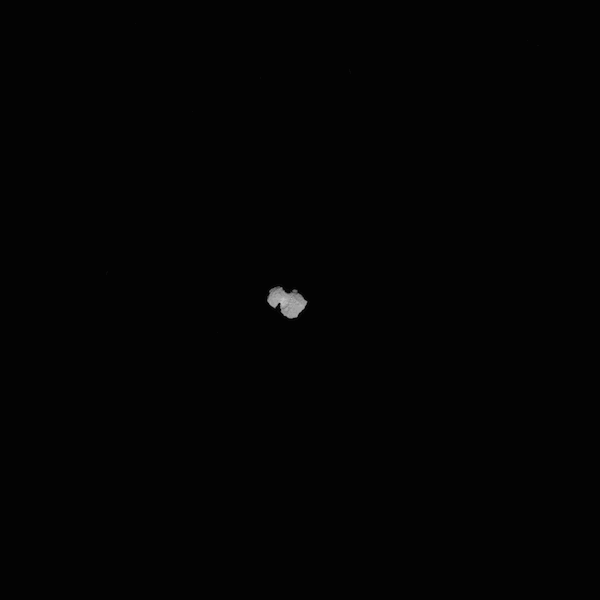 This animation comprises 101 images acquired by the Navigation Camera on board ESA's Rosetta spacecraft as it approached comet 67P/C-G in August 2014. The first image was taken on 1 August at 11:07 UTC (12:07 CEST), at a distance of 832 km. The last image was taken 6 August at 06:07 UTC (08:07 CEST) at a distance of 110 km. Credit: ESA/Rosetta/Navcam
This animation comprises 101 images acquired by the Navigation Camera on board ESA's Rosetta spacecraft as it approached comet 67P/C-G in August 2014. The first image was taken on 1 August at 11:07 UTC (12:07 CEST), at a distance of 832 km. The last image was taken 6 August at 06:07 UTC (08:07 CEST) at a distance of 110 km. Credit: ESA/Rosetta/Navcam
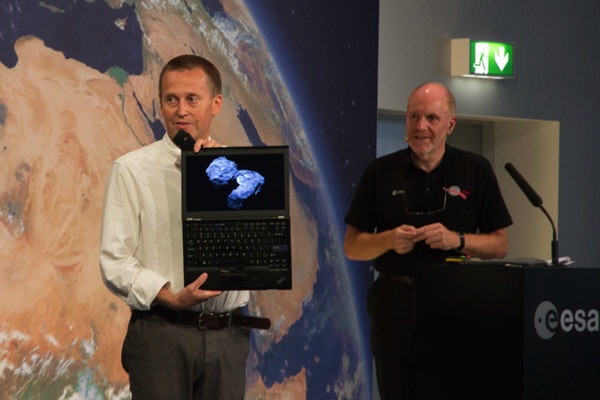 Holger Sierks, lead scientist for Rosetta's imaging system, reveals fresh imagery of comet 67P/Churyumov-Gerasimenko to media and VIPs. Credit: Steven Young/Astronomy Now
Holger Sierks, lead scientist for Rosetta's imaging system, reveals fresh imagery of comet 67P/Churyumov-Gerasimenko to media and VIPs. Credit: Steven Young/Astronomy Now
 Holger Sierks, lead scientist for Rosetta's imaging system, reveals fresh imagery of comet 67P/Churyumov-Gerasimenko to media and VIPs. Credit: Steven Young/Astronomy Now
Holger Sierks, lead scientist for Rosetta's imaging system, reveals fresh imagery of comet 67P/Churyumov-Gerasimenko to media and VIPs. Credit: Steven Young/Astronomy Now
 Holger Sierks, lead scientist for Rosetta's imaging system, reveals fresh imagery of comet 67P/Churyumov-Gerasimenko to media and VIPs. Credit: Steven Young/Astronomy Now
Holger Sierks, lead scientist for Rosetta's imaging system, reveals fresh imagery of comet 67P/Churyumov-Gerasimenko to media and VIPs. Credit: Steven Young/Astronomy Now
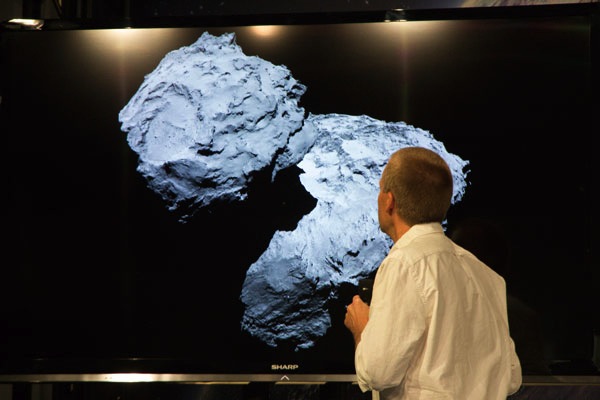 Holger Sierks, lead scientist for Rosetta's imaging system, reveals fresh imagery of comet 67P/Churyumov-Gerasimenko to media and VIPs. Credit: Steven Young/Astronomy Now
Holger Sierks, lead scientist for Rosetta's imaging system, reveals fresh imagery of comet 67P/Churyumov-Gerasimenko to media and VIPs. Credit: Steven Young/Astronomy Now
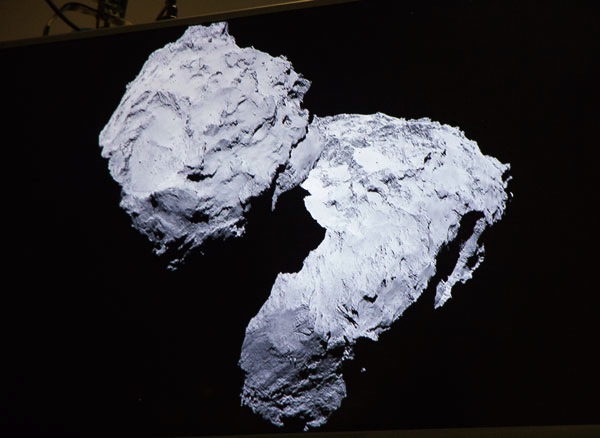 Holger Sierks, lead scientist for Rosetta's imaging system, reveals fresh imagery of comet 67P/Churyumov-Gerasimenko to media and VIPs. Credit: Steven Young/Astronomy Now
Holger Sierks, lead scientist for Rosetta's imaging system, reveals fresh imagery of comet 67P/Churyumov-Gerasimenko to media and VIPs. Credit: Steven Young/Astronomy Now
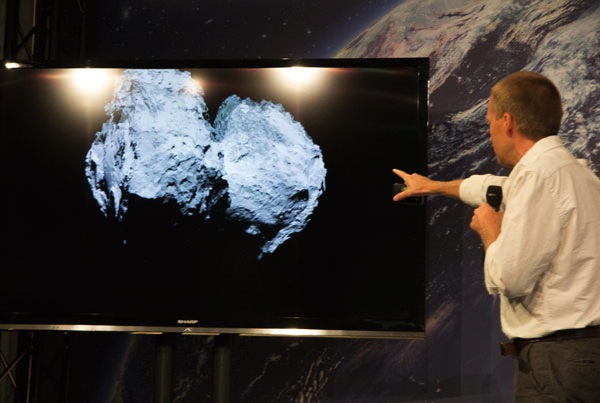 Holger Sierks, lead scientist for Rosetta's imaging system, reveals fresh imagery of comet 67P/Churyumov-Gerasimenko to media and VIPs. Credit: Steven Young/Astronomy Now
Holger Sierks, lead scientist for Rosetta's imaging system, reveals fresh imagery of comet 67P/Churyumov-Gerasimenko to media and VIPs. Credit: Steven Young/Astronomy Now
 Holger Sierks, lead scientist for Rosetta's imaging system, reveals fresh imagery of comet 67P/Churyumov-Gerasimenko to media and VIPs. Credit: Steven Young/Astronomy Now
Holger Sierks, lead scientist for Rosetta's imaging system, reveals fresh imagery of comet 67P/Churyumov-Gerasimenko to media and VIPs. Credit: Steven Young/Astronomy Now
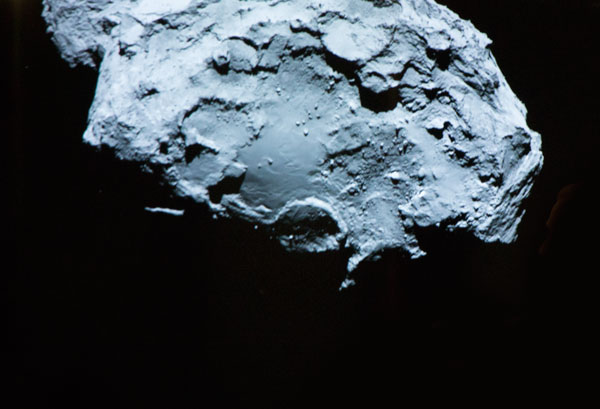 Holger Sierks, lead scientist for Rosetta's imaging system, reveals fresh imagery of comet 67P/Churyumov-Gerasimenko to media and VIPs. This is a photo taken of the image displayed on a television screen. Credit: Steven Young/Astronomy Now
Holger Sierks, lead scientist for Rosetta's imaging system, reveals fresh imagery of comet 67P/Churyumov-Gerasimenko to media and VIPs. This is a photo taken of the image displayed on a television screen. Credit: Steven Young/Astronomy Now
 Another close-up image of comet 67P/Churyumov-Gerasimenko taken by the OSIRIS narrow-angle camera. This is a photo taken of the image displayed on a television screen. Credit: ESA/Rosetta/MPS for OSIRIS Team MPS/UPD/LAM/IAA/SSO/INTA/UPM/DASP/IDA
Another close-up image of comet 67P/Churyumov-Gerasimenko taken by the OSIRIS narrow-angle camera. This is a photo taken of the image displayed on a television screen. Credit: ESA/Rosetta/MPS for OSIRIS Team MPS/UPD/LAM/IAA/SSO/INTA/UPM/DASP/IDA
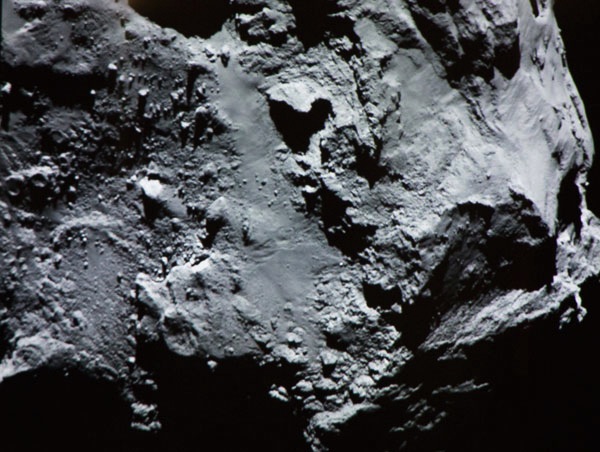 Another close-up image of comet 67P/Churyumov-Gerasimenko taken by the OSIRIS narrow-angle camera. This is a photo taken of the image displayed on a television screen. Credit: ESA/Rosetta/MPS for OSIRIS Team MPS/UPD/LAM/IAA/SSO/INTA/UPM/DASP/IDA
Another close-up image of comet 67P/Churyumov-Gerasimenko taken by the OSIRIS narrow-angle camera. This is a photo taken of the image displayed on a television screen. Credit: ESA/Rosetta/MPS for OSIRIS Team MPS/UPD/LAM/IAA/SSO/INTA/UPM/DASP/IDA
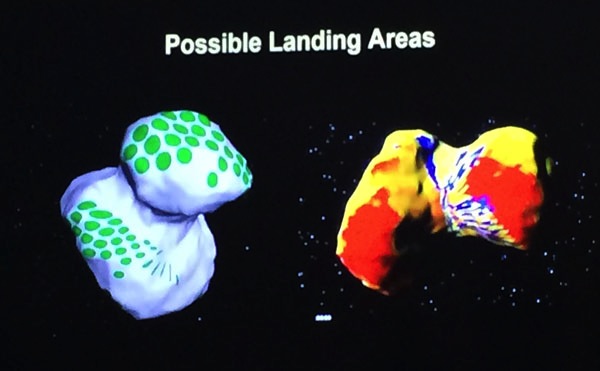 Potential landing areas for Rosetta's Philae lander are shown in green. The other colors represent brightness, with the red areas being the brightest. Credit: ESA/Rosetta/Philae team
Potential landing areas for Rosetta's Philae lander are shown in green. The other colors represent brightness, with the red areas being the brightest. Credit: ESA/Rosetta/Philae team
 A view of outgassing from comet 67P/Churyumov-Gerasimenko super-imposed on an image from Rosetta's OSIRIS camera. This is a photo taken of the image displayed on a television screen. Credit: ESA/Rosetta/MPS for OSIRIS Team MPS/UPD/LAM/IAA/SSO/INTA/UPM/DASP/IDA
A view of outgassing from comet 67P/Churyumov-Gerasimenko super-imposed on an image from Rosetta's OSIRIS camera. This is a photo taken of the image displayed on a television screen. Credit: ESA/Rosetta/MPS for OSIRIS Team MPS/UPD/LAM/IAA/SSO/INTA/UPM/DASP/IDA
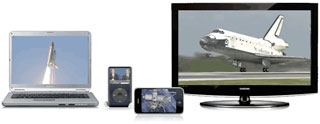

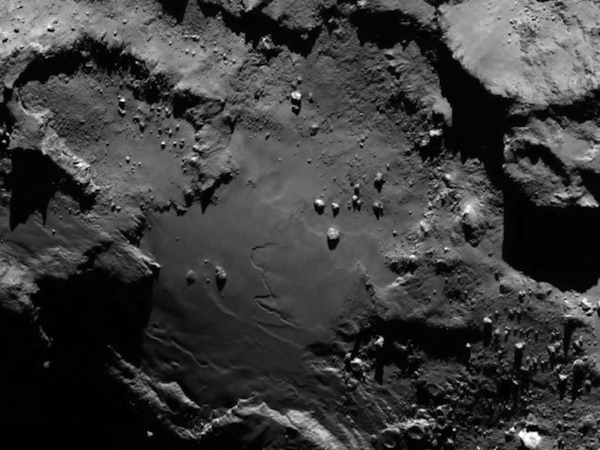 Stunning close up detail focusing on a smooth region on the 'base' of the 'body' section of comet 67P/Churyumov-Gerasimenko. The image was taken by Rosetta's OSIRIS narrow-angle camera and downloaded today, 6 August. The image clearly shows a range of features, including boulders, craters and steep cliffs. The image was taken from a distance of 130 km and the image resolution is 2.4 metres per pixel. Credit: ESA/Rosetta/MPS for OSIRIS Team MPS/UPD/LAM/IAA/SSO/INTA/UPM/DASP/IDA
Stunning close up detail focusing on a smooth region on the 'base' of the 'body' section of comet 67P/Churyumov-Gerasimenko. The image was taken by Rosetta's OSIRIS narrow-angle camera and downloaded today, 6 August. The image clearly shows a range of features, including boulders, craters and steep cliffs. The image was taken from a distance of 130 km and the image resolution is 2.4 metres per pixel. Credit: ESA/Rosetta/MPS for OSIRIS Team MPS/UPD/LAM/IAA/SSO/INTA/UPM/DASP/IDA
 Comet 67P/Churyumov-Gerasimenko by Rosetta's OSIRIS narrow-angle camera on 3 August from a distance of 285 km. The image resolution is 5.3 metres/pixel. Credit: ESA/Rosetta/MPS for OSIRIS Team MPS/UPD/LAM/IAA/SSO/INTA/UPM/DASP/IDA
Comet 67P/Churyumov-Gerasimenko by Rosetta's OSIRIS narrow-angle camera on 3 August from a distance of 285 km. The image resolution is 5.3 metres/pixel. Credit: ESA/Rosetta/MPS for OSIRIS Team MPS/UPD/LAM/IAA/SSO/INTA/UPM/DASP/IDA Comet 67P/Churyumov-Gerasimenko by Rosetta's OSIRIS narrow-angle camera on 3 August from a distance of 285 km. The image resolution is 5.3 metres/pixel. Credit: ESA/Rosetta/MPS for OSIRIS Team MPS/UPD/LAM/IAA/SSO/INTA/UPM/DASP/IDA
Comet 67P/Churyumov-Gerasimenko by Rosetta's OSIRIS narrow-angle camera on 3 August from a distance of 285 km. The image resolution is 5.3 metres/pixel. Credit: ESA/Rosetta/MPS for OSIRIS Team MPS/UPD/LAM/IAA/SSO/INTA/UPM/DASP/IDA Comet 67P/Churyumov-Gerasimenko activity on 2 August 2014. The image was taken by Rosetta's OSIRIS wide-angle camera from a distance of 550 km. The exposure time of the image was 330 seconds and the comet nucleus is saturated to bring out the detail of the comet activity. Note there is a ghost image to the right. The image resolution is 55 metres per pixel. Credit: ESA/Rosetta/MPS for OSIRIS Team MPS/UPD/LAM/IAA/SSO/INTA/UPM/DASP/IDA
Comet 67P/Churyumov-Gerasimenko activity on 2 August 2014. The image was taken by Rosetta's OSIRIS wide-angle camera from a distance of 550 km. The exposure time of the image was 330 seconds and the comet nucleus is saturated to bring out the detail of the comet activity. Note there is a ghost image to the right. The image resolution is 55 metres per pixel. Credit: ESA/Rosetta/MPS for OSIRIS Team MPS/UPD/LAM/IAA/SSO/INTA/UPM/DASP/IDA This animation comprises 101 images acquired by the Navigation Camera on board ESA's Rosetta spacecraft as it approached comet 67P/C-G in August 2014. The first image was taken on 1 August at 11:07 UTC (12:07 CEST), at a distance of 832 km. The last image was taken 6 August at 06:07 UTC (08:07 CEST) at a distance of 110 km. Credit: ESA/Rosetta/Navcam
This animation comprises 101 images acquired by the Navigation Camera on board ESA's Rosetta spacecraft as it approached comet 67P/C-G in August 2014. The first image was taken on 1 August at 11:07 UTC (12:07 CEST), at a distance of 832 km. The last image was taken 6 August at 06:07 UTC (08:07 CEST) at a distance of 110 km. Credit: ESA/Rosetta/Navcam Holger Sierks, lead scientist for Rosetta's imaging system, reveals fresh imagery of comet 67P/Churyumov-Gerasimenko to media and VIPs. Credit: Steven Young/Astronomy Now
Holger Sierks, lead scientist for Rosetta's imaging system, reveals fresh imagery of comet 67P/Churyumov-Gerasimenko to media and VIPs. Credit: Steven Young/Astronomy Now Holger Sierks, lead scientist for Rosetta's imaging system, reveals fresh imagery of comet 67P/Churyumov-Gerasimenko to media and VIPs. Credit: Steven Young/Astronomy Now
Holger Sierks, lead scientist for Rosetta's imaging system, reveals fresh imagery of comet 67P/Churyumov-Gerasimenko to media and VIPs. Credit: Steven Young/Astronomy Now Holger Sierks, lead scientist for Rosetta's imaging system, reveals fresh imagery of comet 67P/Churyumov-Gerasimenko to media and VIPs. Credit: Steven Young/Astronomy Now
Holger Sierks, lead scientist for Rosetta's imaging system, reveals fresh imagery of comet 67P/Churyumov-Gerasimenko to media and VIPs. Credit: Steven Young/Astronomy Now Holger Sierks, lead scientist for Rosetta's imaging system, reveals fresh imagery of comet 67P/Churyumov-Gerasimenko to media and VIPs. Credit: Steven Young/Astronomy Now
Holger Sierks, lead scientist for Rosetta's imaging system, reveals fresh imagery of comet 67P/Churyumov-Gerasimenko to media and VIPs. Credit: Steven Young/Astronomy Now Holger Sierks, lead scientist for Rosetta's imaging system, reveals fresh imagery of comet 67P/Churyumov-Gerasimenko to media and VIPs. Credit: Steven Young/Astronomy Now
Holger Sierks, lead scientist for Rosetta's imaging system, reveals fresh imagery of comet 67P/Churyumov-Gerasimenko to media and VIPs. Credit: Steven Young/Astronomy Now Holger Sierks, lead scientist for Rosetta's imaging system, reveals fresh imagery of comet 67P/Churyumov-Gerasimenko to media and VIPs. Credit: Steven Young/Astronomy Now
Holger Sierks, lead scientist for Rosetta's imaging system, reveals fresh imagery of comet 67P/Churyumov-Gerasimenko to media and VIPs. Credit: Steven Young/Astronomy Now Holger Sierks, lead scientist for Rosetta's imaging system, reveals fresh imagery of comet 67P/Churyumov-Gerasimenko to media and VIPs. Credit: Steven Young/Astronomy Now
Holger Sierks, lead scientist for Rosetta's imaging system, reveals fresh imagery of comet 67P/Churyumov-Gerasimenko to media and VIPs. Credit: Steven Young/Astronomy Now Holger Sierks, lead scientist for Rosetta's imaging system, reveals fresh imagery of comet 67P/Churyumov-Gerasimenko to media and VIPs. This is a photo taken of the image displayed on a television screen. Credit: Steven Young/Astronomy Now
Holger Sierks, lead scientist for Rosetta's imaging system, reveals fresh imagery of comet 67P/Churyumov-Gerasimenko to media and VIPs. This is a photo taken of the image displayed on a television screen. Credit: Steven Young/Astronomy Now Another close-up image of comet 67P/Churyumov-Gerasimenko taken by the OSIRIS narrow-angle camera. This is a photo taken of the image displayed on a television screen. Credit: ESA/Rosetta/MPS for OSIRIS Team MPS/UPD/LAM/IAA/SSO/INTA/UPM/DASP/IDA
Another close-up image of comet 67P/Churyumov-Gerasimenko taken by the OSIRIS narrow-angle camera. This is a photo taken of the image displayed on a television screen. Credit: ESA/Rosetta/MPS for OSIRIS Team MPS/UPD/LAM/IAA/SSO/INTA/UPM/DASP/IDA Another close-up image of comet 67P/Churyumov-Gerasimenko taken by the OSIRIS narrow-angle camera. This is a photo taken of the image displayed on a television screen. Credit: ESA/Rosetta/MPS for OSIRIS Team MPS/UPD/LAM/IAA/SSO/INTA/UPM/DASP/IDA
Another close-up image of comet 67P/Churyumov-Gerasimenko taken by the OSIRIS narrow-angle camera. This is a photo taken of the image displayed on a television screen. Credit: ESA/Rosetta/MPS for OSIRIS Team MPS/UPD/LAM/IAA/SSO/INTA/UPM/DASP/IDA Potential landing areas for Rosetta's Philae lander are shown in green. The other colors represent brightness, with the red areas being the brightest. Credit: ESA/Rosetta/Philae team
Potential landing areas for Rosetta's Philae lander are shown in green. The other colors represent brightness, with the red areas being the brightest. Credit: ESA/Rosetta/Philae team A view of outgassing from comet 67P/Churyumov-Gerasimenko super-imposed on an image from Rosetta's OSIRIS camera. This is a photo taken of the image displayed on a television screen. Credit: ESA/Rosetta/MPS for OSIRIS Team MPS/UPD/LAM/IAA/SSO/INTA/UPM/DASP/IDA
A view of outgassing from comet 67P/Churyumov-Gerasimenko super-imposed on an image from Rosetta's OSIRIS camera. This is a photo taken of the image displayed on a television screen. Credit: ESA/Rosetta/MPS for OSIRIS Team MPS/UPD/LAM/IAA/SSO/INTA/UPM/DASP/IDA
